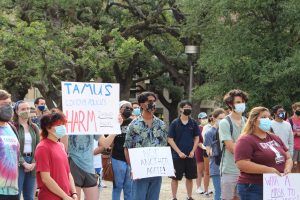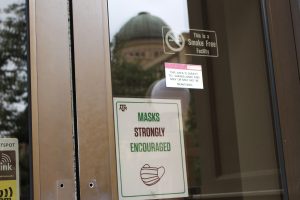Public Health Messaging during Coronavirus Pandemic
Health communication researchers weigh in on why health messaging – and how to communicate effectively – has never been more important. Tragic news of a Texas A&M student's death from COVID-19 complications prompted a campus protest calling for administrators to increase safety measures including more online learning options.
By Ronaldo Mata

Health communication takes many forms from “Masks Strongly Encouraged” posted on campus doors to protest signs urging policy changes including “TAMU’s COVID-19 Policies Harm Disabled Aggies” seen during a Sept. 15 protest following news of the tragic death of a student from complications of COVID-19.
News of the tragic death of a Texas A&M student last week from complications of COVID-19 has underscored how communicating health guidelines and strategic response to the pandemic has never been more crucial to Texas A&M students, faculty and staff.
As the pandemic enters its second year, research into creating effective health messaging across new technologies has never been more important. Messages about transmission – and prevention and treatment – are global concerns. Faculty in the Department of Communication who research health communication strategies weighed in on health messaging around the virus, mis- and disinformation, and how culture and technology all have affected vaccine acceptance, mask wearing and the growth of anti-science beliefs in the general population.
The roots of public health messaging go back to the 1940s when the world was facing another global catastrophe – World War II. Early health promotion during the war focused on the twin problems of public nutrition and food shortages, explained Hart Blanton, professor and head of the Department of Communication. It quickly became clear that messaging was vital to keeping Americans healthy and to have them conserve food, which at times was shipped to soldiers.
Military-made, health-focused messaging evolved into modern public health and health communication.
“A lot of this sort of persuasive and influence techniques that were designed to have people engage in actions that were in the public interest occurred during and after the second world war,” said Blanton, “where there was a sense of common cause, and How do we get citizens working in that spirit?”
President Franklin Roosevelt created the Office of Defense, Health and Welfare Services in response to the need, noted Blanton.
“There, researchers developed campaigns promoting ideas like the notion that consumption of organ meats – kidneys, hearts, livers – was a ‘patriotic’ act that was healthy and conserved national resources – red meat,” he explained. The agency eventually disbanded but today is considered a precursor to what is now the Department of Health and Human Services.
Signs of the Times
 Today, health communication has transcended the home front and trenches of World War II and is useful in a variety of health-related fields, many of them ripped straight from the headlines. The lessons from history still inform public health messaging’s vital role today, said Blanton.
Today, health communication has transcended the home front and trenches of World War II and is useful in a variety of health-related fields, many of them ripped straight from the headlines. The lessons from history still inform public health messaging’s vital role today, said Blanton.
It is easy to overlook the “Masks Strongly Encouraged” signs on every campus door, along with fading dot stickers on the floors of academic buildings and grocery stores suggesting six-feet of physical distance. Both are examples of health communication, said Richard Street, who has been teaching and researching health communication for 33 years. As new technology has emerged, new research is needed about how health messaging is best communicated on new platforms.
“In a traditional sense, public health is more about, from a communication point of view, communicating messages through whatever media platforms you can get in order to reach and persuade certain groups of people to engage in healthier practices,” Street explained.
Health communication also intersects in clinical health settings, noted Street. Amid the coronavirus early lockdown, cancer patients’ consultations were abruptly shifted to telehealth. How that technology shift affected patients – and healthcare professionals – became an immediate focus for Street and his research team. By surveying patients about their telehealth experiences, the data could be used to help providers find effective ways to communicate with this new approach.
Messages vs Actions

“Masks Strongly Encouraged” signs around campus have had limited effect on students wearing masks in classrooms according to professors and some students.
Unlocking the secrets to producing effective messaging – and why poor messaging fails – is the focus of many health communication faculty and graduate students. Normative influence, attitude change and attitude-behavior modeling are all key, explained Blanton, who completed his doctorate in social psychology at Princeton before coming to Texas A&M. Solutions – effective messaging – are only possible after identifying the reasons poor messaging has failed, he added.
“The general approach that I and others work off is that one of the best ways to influence the actions people are going to engage in is to influence their attitudes towards that behavior,” noted Blanton.
Pandemic mask wearing – and the obstacles to widespread adoption of this simple, effective health strategy – is affected by external factors like political pressure, belief structures and the simple wish to “fit in,” Blanton said. Despite being in a person’s best interest, “normative influences” contribute to opposition to masks as a public good, he explained.
How this affects individual decision making, said Blanton, is why appeals to the virtue of mask wearing have not been 100 percent effective. What type of messages are needed – whether attitude-based or norms-based in a given situation – is the type of question health communicators seek to answer, said Blanton. That may be creating a message of how to make someone feel comfortable wearing a mask by acting out their own attitudes and based on their own beliefs, he explained.

Faculty Senate Speaker Dale Rice said during a recent Senate meeting with President Katherine Banks that “it would be possible for us to push back” and seek improved messaging surrounding mask wearing.
Misinformation and disinformation around COVID-19 vaccines has hindered the public health goal of fully vaccinating 20 million Americans since vaccines became available on December 14, 2020. Currently, only 49% of Texans have been fully vaccinated; 46% of the U.S. population remains unvaccinated.
How social media has affected emerging infectious diseases like COVID-19 is a research focus for Lu Tang, Ph.D. and associate professor of health communication. That includes how mask-wearing has sparked hyper-politicization.Tang noted that while social media connects people in new ways, it also fragments society in ways never before seen.
“Journalists are gatekeepers,” said Tang, who also teaches about the role culture plays in health communication. “So they’re professionally trained, and they have this ethical responsibility to tell the truth.
“Social media don’t have this kind of professionally trained, ethically bound gatekeepers,” Tang explained. “So whoever has an account can say what they want.”
Finding Facts
Misinformation and a growing distrust in science are some of the biggest hurdles facing health communication, Tang noted. While algorithms were created to show posts of favorite loved ones, Tang argues they also contribute to “filter bubbles” of viral misinformation that make users seemingly allergic to information that goes against personal beliefs.
“As a result, it’s very difficult to do good health messaging across the entire population because there are groups of people that are very, very difficult for you to reach,” said Tang.
On a college campus, flyers and stickers can only do so much. Faculty Senate Speaker Dale Rice addressed mask messaging at a recent Senate meeting with University President Katherine Banks.
“I do think that we might want to, as a senate, look at addressing this more seriously,” Rice said as the meeting came to a close. “I will disagree wholeheartedly with President Banks. I think our communication over masking has been an absolute joke. It has been a dismal failure. It consists of signs saying ‘masking strongly encouraged,’ and I don’t think what has appeared on social media and in other ways across campus has been any kind of unified message about the importance of masking.”
Street addressed a lack of mask wearing in his classes, as well.
“You gotta understand the mind of a college student, particularly a college student with a peer group,” Street noted. “In my class, I have maybe one-quarter of the people wear masks. Three-quarters do not.”
Convincing young people their health is at risk is not as effective as appealing to their sense of responsibility and community, explained Blanton.
“I don’t have to convince [a] health care worker to wear their masks,” said Blanton. “They’re going to do it. But I may need to convince college students of their masks so the health-care worker’s grandmother doesn’t contract the disease.”
Each individual student’s decision isn’t their own rational decision, agreed Tang.
“It’s not like they’re doing a math problem,” she noted. “Their decision is based on who they are, where they’re from, who their parents are, who their friends are, which church they go to – all those things.”
Ultimately, a simple behavior such as wearing a mask or getting a vaccine demonstrates how complex the strategy has to be for different groups, said Blanton. The intricacies of effective health communication around COVID-19 in cities – whether rural, urban or collegiate – show how messaging has to be based on research into individuals and groups.
“The situation you’re talking about shows you again, just how complex a really simple behavior can be,” Blanton said.
